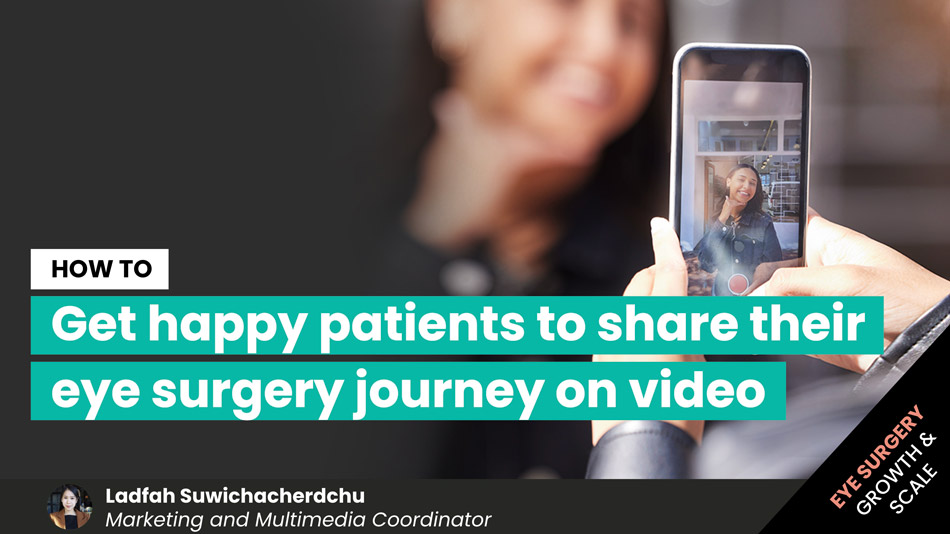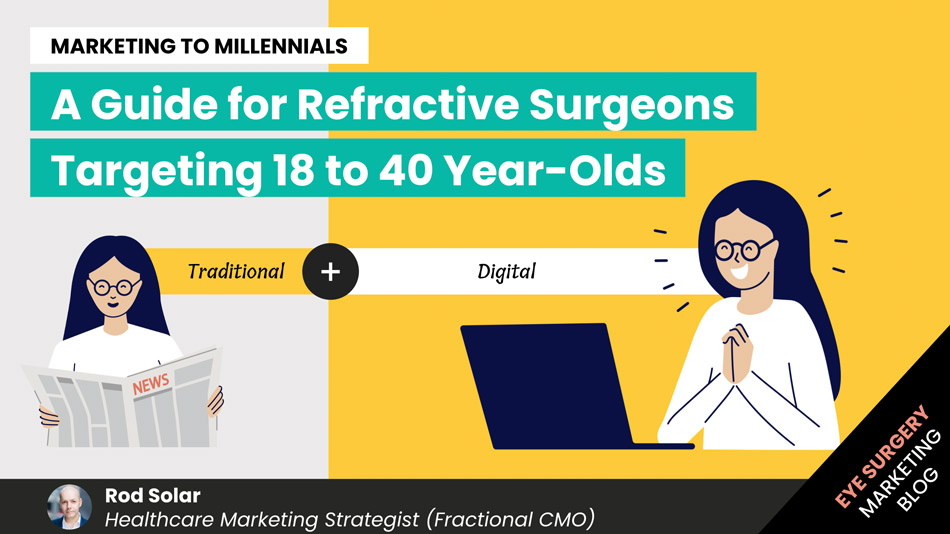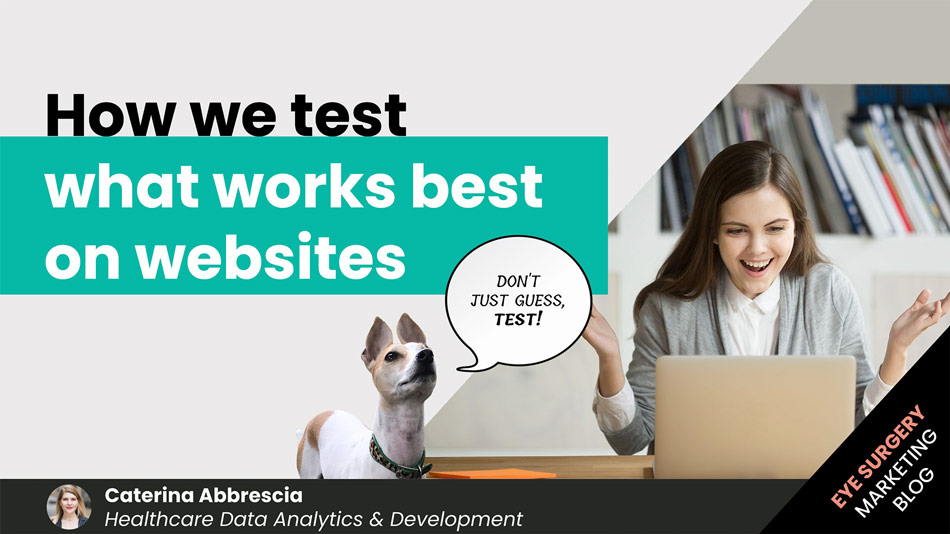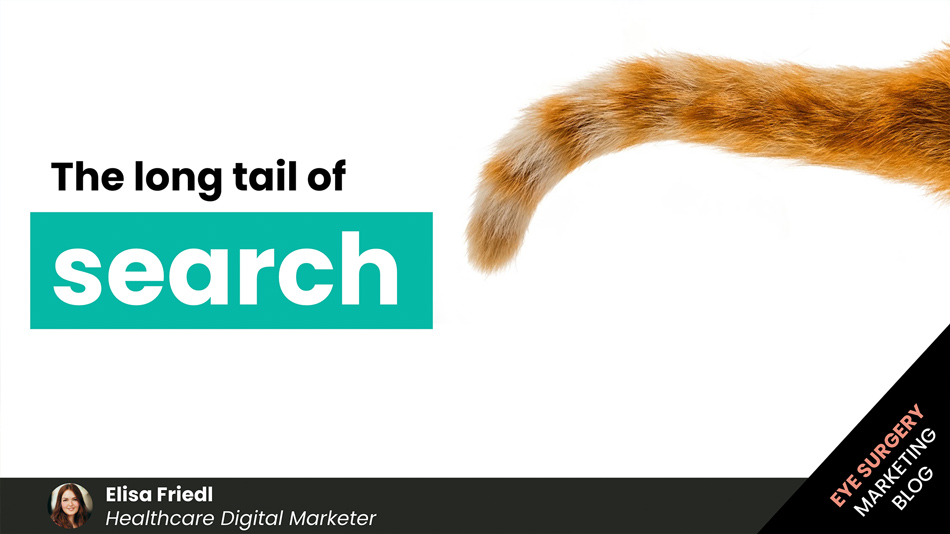
What’s the No 1 mistake most surgeons make when evaluating SEO?
You’ve probably heard of SEO (Search Engine Optimisation). Perhaps you’ve tried SEO with mixed results. Today, I’ll explain a common mistake most refractive surgeons make when it comes to planning and writing content for SEO. If you’re looking for a way to boost your content strategy in 2022 and maximise organic conversions, this post is for you.
But first, what’s the mistake most surgeons make when evaluating SEO? They think it’s a one-race game. If you think that the only race worth winning is to get to the number 1 spot for the most popular term, you’re missing out on hundreds, if not thousands, of other races worth participating in.
Even worse, you may feel that if you’re not winning this race, then you’ve lost.
The reality is there are thousands of simultaneous races running for thousands of different keyword phrases. By focusing on the vanity race, you may be losing on out much more traffic and many more conversions.
It’s not an easy concept to get your head around if you’re unfamiliar with how people search and how Google works. Let’s start by talking about what a search query is.
What is a search query?
A search query is the phrase a searcher types into Google Search. Understanding different types of search queries remain central to your success with search marketing.
A typical search query might look like this:

Look at how many results there are (123,000,000). That’s a massively competitive search query! We call that kind of search query a “head” term.
A “fat middle” term search query can also look like this:

Note the fewer relative number of results. While high, it has considerably less competition. Furthermore, you can imagine that reaching the top for that term will result in some quality clicks from people who know more about what they want. We call this kind of search query a “fat middle” term.
Now look at this “long-tail” search query:

Even less competition, right? You can be pretty sure that people searching this query have commercial intent and are keen to go with the best option (e.g. the first result for that keyword phrase). We call this type of search query a “long-tail” term.
Why these all of these different types of search queries with these fancy marketing names? Look at this dinosaur below. It’s one of the best illustrations that demonstrates the difference between head, fat middle and long-tail search terms.
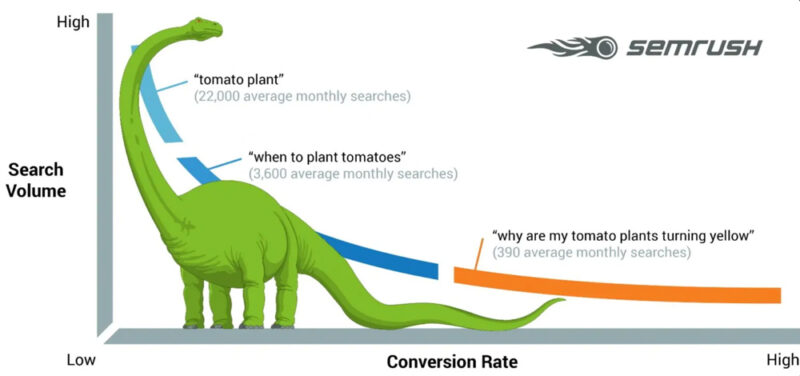
While all related to the same services, these search queries have
- different intent behind them
- are likely asked at different stages of the funnel, and
- will likely yeild significantly different results.
A head term, otherwise known as a head keyword, is a popular keyword that drives high search volume (i.e. “tomato plant” or “laser eye surgery”). Naturally, most of businesses who want to rank on Google want to rank for head terms. However, head terms are extremely competitive when it comes to ranking and they don’t convert well because searchers tend to be very high up in the funnel (i.e. the farthest away from booking).
On the opposite side of the chart is the long-tail term. Long-tail keyword searches are highly specific, so users mostly know exactly what they are looking for when searching (i.e. “why are my tomato plants turning yellow” or “how much does the best laser eye surgery in London cost?”. People searching for these types of terms have a specific question and want a specific answer. In commercial terms, they are lower down the sales funnel and are more likely to book.
So, let us say you aim to get people to book first appointments with you to determine their suitability for laser vision correction.
NOTE: The best way to answer that nagging question about practice growth or marketing or patient volume in the back of your mind is to book a free 15-minute compatibility call. Get some options and go away with a clear idea of what’s possible.
Which queries should you target?
- “Laser Eye Surgery London”
- “Who is the best laser eye surgeon in London?”
- “Can LASIK eye surgery fix my astigmatism?”
- “How much does laser eye surgery cost in London?”
- “Can you drive after having laser eye surgery?”
You might find that there are more people searching for some of these queries than others. Marketers quantify the popularity of search phrases by looking at keyword volume. Keyword volume refers to the average number of monthly searches for a given keyword over a 12-month period.
1Source: SEMrushLook at the keyword volume for each of these phrases:
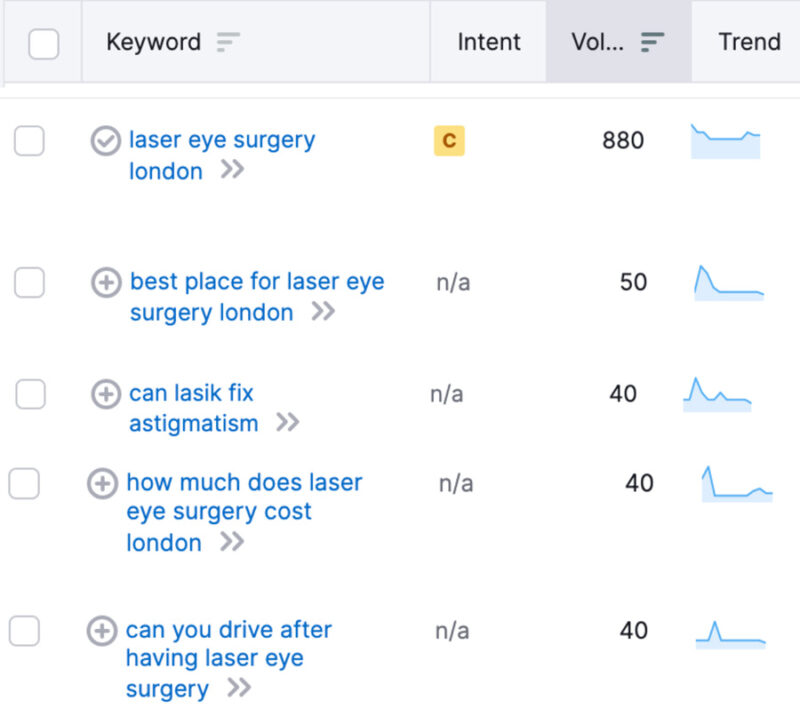
If you’re trying to acquire new patients through organic search, you’re likely thinking “To get as many conversions as possible, I’ll solely focus on high volume search queries because most people will look up these phrases”. Right?
Wrong.
Here’s why: When trying to get in front of big groups of people, your chance of standing out is slim.
Imagine standing in the middle of a large school gymnasium and trying to get people to listen to what you have to say.
Making all of them listen to you while others fight to achieve the same thing can be really hard. It’s crowded, noisy and your competition might be more popular than you and has already established a sense of recognition with the audience.
Additionally, you’re trying to appear relevant for everyone in the room, which is why you’re making your message as broad as possible.
Now imagine being in small classroom.
Not only will the number of others that are also trying to get the spotlight be much smaller than in the school gymnasium – you’re also able to tailor your message relevant to what your audience cares about most.
In this smaller group, you’ll likely get more people to actively listen and engage with you.
The same applies to search queries. The search demand curve shows how query popularity interacts with competition and conversion.
As I showed you above, the search demand curve resembles a dinosaur.
On the left-hand side of the curve, we have the dinosaur’s head. Here you have the top 100 keywords queried which accounts for 18.5 percent of all queries.
The middle of the curve is the body (the “fat middle”) where you have the top 500-10,000 keywords. The body accounts for 11.5 percent of all queries.
As the curve inexorably moves rightward, we have what marketers refer to as the long tail of search.
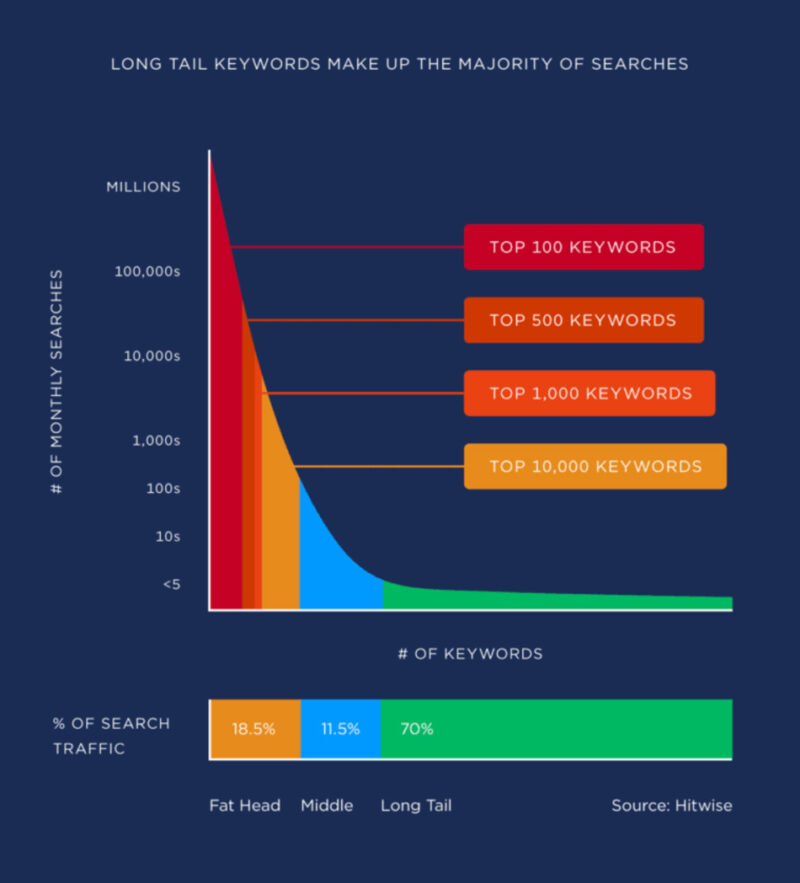
The long tail accounts for an astounding 70 percent of all search queries. Now you have a theoretically infinite combination of keywords that together far exceed the number of search queries that are more popular.
This means that, when writing content for a long tail search query:
- There is less competition to show up in Google’s top 3. Therefore, your chance of getting a high ranking search engine result is higher.
- Your click-through rate improves. Long-tail keywords are more specific and can precisely match the search intent of the query – Therefore, the chance of getting a patient to click on your search result is higher.
- Your conversion rate improves. Those that click on your search result get an answer tailored to what they care about in this moment (i.e. an answer to their question). Based on the specificity of the search query we can assume that these people are further down the patient funnel – hence closer to committing to an appointment or enquiry. Therefore, the likelihood of getting bookings from these visitors increases.
Long tail searches are low volume, but they do have redeeming qualities
The further up the head the query, the higher the competition and the lower the conversion rates. The further down the long tail the query the lower the competition and the higher the conversion rates.
Google reports that 1 out of 5 queries have never been typed in the search engine before. That is a remarkably long tail!
Should you focus your efforts along the long tail only and ignore high volume search phrases?
No! Why not target all of them? We recommend you target intent and context and build assets across the entire demand curve, particularly the long tail.
You can create as many assets as you wish on your website, one responding to just the right context for every query. An easy way to do this is by regularly publishing blog posts. Improving your Google My Business listing for local SEO can give you a powerful advantage when it comes to those popular high-volume search queries.
Boost your chance to stand out with Paid Traffic
Remember that big room of 800 people? A powerful tool to stand out in the midst of large crowds is using a microphone. In marketing, you can think of paid traffic as your microphone – your ads are boosted to the top if you spend enough per click to overpower your competitors. Click here to learn what paid traffic is and how you can use it to generate awareness for your medical practice.
Now that you’ve learnt which search queries you should focus on, it’s time to produce content that your audience really cares about (Click here to learn content writing principles for effective digital communication). We suggest using SEO tools (the most precise and easy to use tool we’ve found is Semrush) to research commonly asked questions in your market.
NOTE: The best way to answer that nagging question about practice growth or marketing or patient volume in the back of your mind is to book a free 15-minute compatibility call. Get some options and go away with a clear idea of what’s possible.
About the author
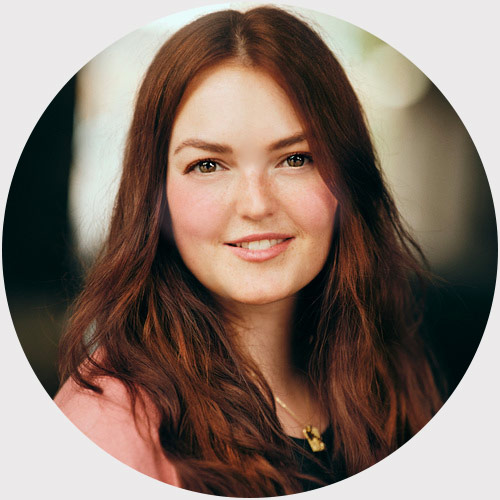
Elisa Friedl
Customer Success & Growth Manager
Hi, I’m Elisa. As a Success & Growth Manager at LiveseySolar, I work as a junction between our customers and our team.
Since joining LiveseySolar in 2019, I’ve learned how to develop meaningful relationships with your patients by designing strategies to generate awareness, engage your audience, utilise lead magnets, entry point offers and profit maximisers to amplify core offers and increase sales.
I also lead LiveseySolar’s Paid Traffic Campaigns aiming to get you in more leads from Google and social media advertising.
Seeing my customers grow their businesses and surpass their goals makes me proud.
Related Posts
Meet our Co-Founders
We’re passionate about helping leaders of high-quality, growth-minded practice owners double their practice revenue
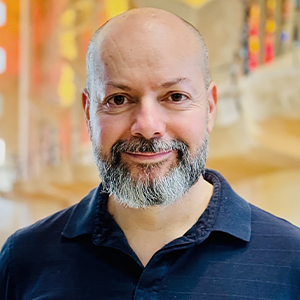
Rod Solar
Founder & Scalable Business Advisor
For over 20 years, I’ve helped ophthalmology entrepreneurs scale their private practices. I specialise in doubling revenue within three years by offering a proven framework, hands-on experience, and a team of experts who implement what works. We take the guesswork out of growth and scale, so you can focus on delivering exceptional patient care while maximising the value of your business.
LiveseySolar completely transformed the way we were approaching this… We’ve gone from having just the dream of having a practice to having a practice up and running with people making inquiries and booking for procedures… It’s extremely pleasing. We feel lucky we connected with LiveseySolar.
— Dr Matthew Russell, MBChB, FRANZCO, specialist ophthalmic surgeon and founder of VSON and OKKO

Laura Livesey
Founder & CEO
I’m the co-founder & CEO of LiveseySolar. I’ve developed powerful eye surgery marketing systems that increase patient volumes and profits for doctors, clinics, and hospitals, since 1997.
Rod and Laura know as much about marketing surgery to patients as I know about performing it. They are an expert in the field of laser eye surgery marketing. They know this industry inside out. I believe that they could help many companies in a variety of areas including marketing materials, sales training and marketing support for doctors.
— Prof. Dan Reinstein, MD MA FRSC DABO, founder of the London Vision Clinic, UK







